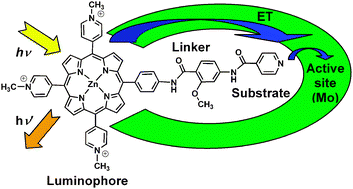Design and synthesis of water soluble (metallo)porphyrins with pendant arms: studies of binding to xanthine oxidase†
Abstract
The tethering of a substrate analogue to a covalently attached luminophore may give rise to a

* Corresponding authors
a
Department of Chemistry, The University of York, Heslington, York, UK
E-mail:
rnp1@york.ac.uk
Tel: +44 (0)1904 432549
The tethering of a substrate analogue to a covalently attached luminophore may give rise to a

 Please wait while we load your content...
Something went wrong. Try again?
Please wait while we load your content...
Something went wrong. Try again?
E. A. Gibson, Anne-K. Duhme-Klair and R. N. Perutz, New J. Chem., 2010, 34, 1125 DOI: 10.1039/B9NJ00736A
To request permission to reproduce material from this article, please go to the Copyright Clearance Center request page.
If you are an author contributing to an RSC publication, you do not need to request permission provided correct acknowledgement is given.
If you are the author of this article, you do not need to request permission to reproduce figures and diagrams provided correct acknowledgement is given. If you want to reproduce the whole article in a third-party publication (excluding your thesis/dissertation for which permission is not required) please go to the Copyright Clearance Center request page.
Read more about how to correctly acknowledge RSC content.
 Fetching data from CrossRef.
Fetching data from CrossRef.
This may take some time to load.
Loading related content
